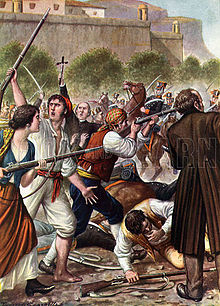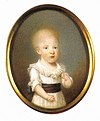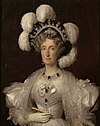Ferdinand I of the Two Sicilies
| Ferdinand I | |||||
|---|---|---|---|---|---|
King of Sicily | |||||
| Reign | 6 October 1759 – 12 December 1816 | ||||
| Predecessor | Charles III | ||||
| Born | 12 January 1751 Royal Palace, Naples | ||||
| Died | 4 January 1825 (aged 73) Naples, Two Sicilies | ||||
| Burial | |||||
| Spouses | |||||
| Issue Detail |
| ||||
| |||||
Roman Catholic | |||||
| Signature | |||||
Ferdinand I (12 January 1751 – 4 January 1825) was
Ferdinand was born in Naples as the third son of
Childhood

Ferdinand was born in
Ferdinand was his parents' third son; his elder brother Charles was expected to inherit Naples and Sicily. When his father ascended the Spanish throne in 1759 he abdicated the thrones of Naples and Sicily in Ferdinand's favour in accordance with the treaties forbidding the union of the two crowns. A regency council presided over by the Tuscan Bernardo Tanucci was set up. Tanucci, an able, ambitious man, wishing to keep the government as much as possible in his own hands, purposely neglected the young king's education, and encouraged him in his love of pleasure, his idleness and his excessive devotion to outdoor sports.[1][2]
Reign
Ferdinand's minority/childhood ended in 1767, and his first act was the expulsion of the
Tanucci, who attempted to thwart her, was dismissed in 1777. The Englishman Sir
French occupation and the Parthenopaean Republic
Although peace was made with France in 1796, the demands of the
The French entered the city in spite of the fierce resistance of the
The king, and above all the queen, were particularly anxious that no mercy should be shown to the rebels, and Maria Carolina (a sister of the executed Marie Antoinette) made use of Lady Hamilton, Nelson's mistress, to induce Nelson to carry out her vengeance.[2]
Third Coalition
The king returned to Naples soon afterwards, and ordered a few hundred who had collaborated with the French executed. This stopped only when the French successes forced him to agree to a treaty which included amnesty for members of the French party. When the War of the Third Coalition broke out between France and Austria in 1805, Ferdinand signed a treaty of neutrality with the former, but a few days later he allied himself with Austria and allowed an Anglo-Russian force to land at Naples.[2]

The French victory at the Battle of Austerlitz on 2 December enabled Napoleon to launch an invasion of the Kingdom of Naples. Ferdinand fled to Palermo on 23 January 1806, followed soon after by his wife and son, and on 14 February 1806 the French again entered Naples. Napoleon declared that the Bourbon dynasty had forfeited the crown, and proclaimed his brother Joseph King of Naples and Sicily. But Ferdinand continued to reign over the latter kingdom (becoming the first King of Sicily in centuries to actually reside there) under British protection.[2]
Parliamentary institutions of a feudal type had long existed on the island, and
Restoration

After the fall of Napoleon,
Ferdinand was now completely subservient to Austria, an Austrian,
1820 revolution

The suppression of liberal opinion caused an alarming spread of the influence and activity of the secret society of the Carbonari, which in time affected a large part of the army.[2] In July 1820, a military revolt broke out under General Guglielmo Pepe, and Ferdinand was terrorised into signing a constitution on the model of the Spanish Constitution of 1812. On the other hand, a revolt in Sicily, in favour of the recovery of its independence, was suppressed by Neapolitan troops.
The success of the military revolution at Naples seriously alarmed the powers of the
The Neapolitans, commanded by General Pepe, made no attempt to defend the difficult
Later years
Following the Austrian victory, the Parliament was dismissed and Ferdinand suppressed the Liberals and Carbonari. The victory was used by Austria to force its grasp over Naples' domestic and foreign policies.
Ferdinand died in Naples on 4 January 1825. He was the last surviving child of Charles III.
Cultural depictions
- That Hamilton Woman (1941) directed by Alexander Korda, played by Luis Alberni
- Ferdinando and Carolina (1999) directed by Lina Wertmüller, played by Sergio Assisi, Adriano Pantaleo, and Mario Scaccia at different ages
- Luisa Sanfelice (2004) directed by Paolo and Vittorio Taviani, played by Emilio Solfrizzi
Issue
| Children of Ferdinand I | ||||
|---|---|---|---|---|
| Name | Picture | Birth | Death | Notes |
| By Maria Carolina of Austria (Vienna, 13 August 1752 – Vienna, 8 September 1814) | ||||
| Maria Teresa Carolina Giuseppina |  |
6 June 1772 | 13 April 1807 | Named after her maternal grandmother, Maria Theresa of Austria, she married her first cousin Francis II, Holy Roman Emperor in 1790; had issue.
|
| Maria Luisa Amelia Teresa |  |
Royal Palace of Naples , 27 July 1773 |
Hofburg Imperial Palace , 19 September 1802 |
Married her first cousin Ferdinand III, Grand Duke of Tuscany and had issue. |
| Carlo Tito Francesco Giuseppe |  |
Naples, 6 January 1775 | 17 December 1778 | Died of smallpox. |
| Maria Anna Giuseppa Antonietta Francesca Gaetana Teresa |  |
23 November 1775 | 22 February 1780 | Died of smallpox. |
| Francesco Gennaro Giuseppe Saverio Giovanni Battista |  |
Naples, 14 August 1777 | Naples, 8 November 1830 | Married his cousin Infanta Maria Isabella of Spain in 1802 and had issue; was King of the Two Sicilies from 1825 to 1830.
|
| Maria Cristina Teresa |  |
Caserta Palace , 17 January 1779 |
Savona, 11 March 1849 | Married Charles Felix of Sardinia in 1807; had no issue; it was she who ordered the excavations of Tusculum. |
| Maria Cristina Amelia | Caserta Palace, 17 January 1779 | Caserta Palace, 26 February 1783 | Died of smallpox. | |
| Gennaro Carlo Francesco |  |
Naples 12 April 1780 | 2 January 1789 | Died of smallpox. |
| Giuseppe Carlo Gennaro |  |
Naples, 18 June 1781 | 19 February 1783 | Died of smallpox. |
| Maria Amelia Teresa |  |
Caserta Palace, 26 April 1782 | Claremont House, 24 March 1866 | Married in 1809 Duke of Orleans , King of the French and had issue.
|
| Maria Cristina | Caserta Palace, 19 July 1783 | Caserta Palace, 19 July 1783 | Stillborn. | |
| Maria Antonietta Teresa Amelia Giovanna Battista Francesca Gaetana Maria Anna Lucia |  |
Caserta Palace, 14 December 1784 | Royal Palace of Aranjuez, 21 May 1806 | Married her cousin Infante Ferdinand, Prince of Asturias ; died from tuberculosis; had no issue.
|
| Maria Clotilde Teresa Amelia Antonietta Giovanna Battista Anna Gaetana Polcheria | Caserta Palace, 18 February 1786 | 10 September 1792 | Died of smallpox. | |
| Maria Enrichetta Carmela | Naples, 31 July 1787 | Naples, 20 September 1792 | Died of smallpox. | |
| Carlo Gennaro | Naples, 26 August 1788 | Caserta Palace, 1 February 1789 | Died of smallpox. | |
| Leopoldo Giovanni Giuseppe Michele of Naples |  |
Naples, 2 July 1790 | Naples, 10 March 1851 | Married his niece Archduchess Clementina of Austria and had issue.
|
| Alberto Lodovico Maria Filipo Gaetano |  |
2 May 1792 | Died on board HMS Vanguard, 25 December 1798 | Died in childhood (died of exhaustion on board HMS Vanguard). |
Maria Isabella |
 |
Naples, 2 December 1793 | 23 April 1801 | Died in childhood. |
Ancestry
| Ancestors of Ferdinand I of the Two Sicilies Augustus II of Poland | |||||||||||||
|---|---|---|---|---|---|---|---|---|---|---|---|---|---|
| Augustus III of Poland | |||||||||||||
| Christiane Eberhardine of Brandenburg-Bayreuth | |||||||||||||
| Maria Amalia of Saxony | |||||||||||||
| Joseph I, Holy Roman Emperor | |||||||||||||
| Maria Josepha of Austria | |||||||||||||
| Wilhelmine Amalie of Brunswick | |||||||||||||
Heraldry
- Heraldry of Ferdinand of Naples, Sicily and the Two Sicilies
-
Coat of arms as King of Naples
(1759–1799 / 1799–1806 /1814–1816)[6] -
Coat of arms as King of Sicily
(1759–1816)[6] -
Coat of arms as King of the Two Sicilies
(1816–1825)[6]
References
- ISBN 9780571249015.
- ^ a b c d e f g h i j k l m One or more of the preceding sentences incorporates text from a publication now in the public domain: Chisholm, Hugh, ed. (1911). "Ferdinand IV. of Naples". Encyclopædia Britannica. Vol. 10 (11th ed.). Cambridge University Press. pp. 264–265.
- ISBN 9780198207559.
- ^ Oman, Carola, Nelson, 1950 ed., pp.293-4
- ^ Genealogie ascendante jusqu'au quatrieme degre inclusivement de tous les Rois et Princes de maisons souveraines de l'Europe actuellement vivans [Genealogy up to the fourth degree inclusive of all the Kings and Princes of sovereign houses of Europe currently living] (in French). Bourdeaux: Frederic Guillaume Birnstiel. 1768. p. 9.
- ^ a b c "Le origini dello stemma delle Due Sicilie, Ferdinando IV, poi I". Storia e Documenti (in Italian). Real Casa di Borbone delle Due Sicilie. Archived from the original on 10 April 2013. Retrieved 24 March 2013.

![Coat of arms as King of Naples (1759–1799 / 1799–1806 /1814–1816)[6]](http://upload.wikimedia.org/wikipedia/commons/thumb/6/6c/Greater_Coat_of_Arms_of_Ferdinand_IV_of_Naples.svg/125px-Greater_Coat_of_Arms_of_Ferdinand_IV_of_Naples.svg.png)
![Coat of arms as King of Sicily (1759–1816)[6]](http://upload.wikimedia.org/wikipedia/commons/thumb/5/5c/Coat_of_Arms_of_Ferdinand_III_of_Sicily.svg/125px-Coat_of_Arms_of_Ferdinand_III_of_Sicily.svg.png)
![Coat of arms as King of the Two Sicilies (1816–1825)[6]](http://upload.wikimedia.org/wikipedia/commons/thumb/c/ce/Great_Royal_Coat_of_Arms_of_the_Two_Sicilies.svg/122px-Great_Royal_Coat_of_Arms_of_the_Two_Sicilies.svg.png)